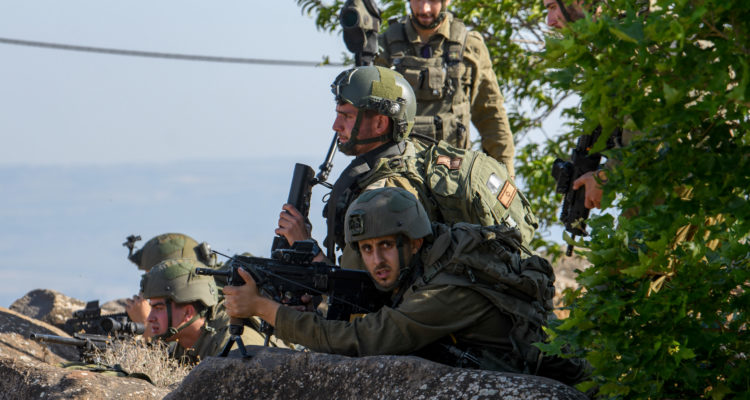The decision for escalation now lies with Israel.
By Jonathan Spyer, The Spectator via Middle East Forum
Tensions on Israel’s northern border are currently at their highest point since the outbreak of hostilities in October last year. On Friday, United Nations Secretary-General Antonio Guterres said: ‘One rash move – one miscalculation – could trigger a catastrophe that goes far beyond the border, and frankly, beyond imagination.’
The latest reports indicate that the US has declared it will give Israel its ‘full support’ in the event of war with Hezbollah. This appears to go hand in hand, however, with an American determination to prevent any Israeli action which might precipitate such a war. So what is the current situation? And where are things heading?
After a short pause for the Islamic Eid al-Adha holiday, the Iranian proxy Hezbollah is now back to launching rockets and drones at targets on the Israeli side of the border on a daily basis. Israel is responding with targeted strikes on Hezbollah fighters and commanders.
As of today, the tactical advantage is clearly with Israel. This is reflected in the casualty figures. Hezbollah acknowledges the deaths of 345 fighters at the hands of Israel since October, along with dozens of civilians. (It is worth noting that in the last round of fighting, in 2006, the movement admitted to losing only 250 fighters). Hezbollah has suffered the loss of senior and seasoned commanders. On the Israeli side, losses are much lighter – 15 IDF soldiers, 10 civilians.
These figures are somewhat deceptive, however. First, because the low Israeli civilian losses reflect the fact that Israeli border communities have emptied out. To a depth of around 5km from the border, the civilians have gone. Around 60,000 Israelis have become what in other contexts are usually known as internally-displaced persons, or less euphemistically, refugees. On the other side of the border, 100,000 Lebanese have similarly left their homes.
Second, the picture of Israeli tactical advantage is deceptive because strategically the advancing party is clearly Iran, not Israel. Israeli strategists and commanders prior to October 2023 used to talk proudly of what they called the ‘war between the wars.’ This was an intelligence and air-led campaign to disrupt and frustrate Iranian efforts to equip its Hezbollah proxy. The campaign also aimed to frustrate Tehran’s efforts to deepen and consolidate its line of control between the Iraq-Iran border and Lebanon.
The campaign scored many tactical successes. Much ordnance was destroyed, many fighters were killed. But at the end of it, as may now be plainly seen, Iran possesses something close to a fully-equipped army on Israel’s northern border. It is now using that army, in coordination with its Hamas client in Gaza and proxy forces elsewhere in the region, to wage a coordinated assault on Israel and its allies.
For Israel, the long-term abandonment of the north, and the ceding of it to Hezbollah, is not tenable. Israeli civilians have made clear that they will not return to their homes if Hezbollah remains deployed along the border. There are family homes just meters from the borderline. Before October, Hezbollah members would regularly deploy along this area, with only a low fence separating them from Israeli civilian communities. The risk of a 7 October style massacre, but on a far larger scale, would be ever-present should these communities be re-populated without a change in arrangements on the other side of the border.
Despite the efforts of both the US and France, progress in this area has been elusive. Hezbollah leader Hassan Nasrallah has made clear that his side is not currently seeking all-out war. He has also stated that his movement will continue its current wave of attacks for as long as the fighting in Gaza continues. There are no indications that he will concede to any diplomatic move which would involve the distancing of Hezbollah fighters from the border.
There is already a Security Council resolution that prohibits Hezbollah from deploying south of the Litani River. Resolution 1701, however, which ended the 2006 war, has been a dead letter from the outset. There is no force available to enforce it. The Lebanese army is weaker than Hezbollah, and is in any case heavily infiltrated by it. The United Nations Interim Force in Lebanon (UNIFIL) has no mandate to use force against the Shia Islamists and its contributor states have absolutely no will to do so. The result is that Hezbollah is there, on the border, refusing to move, and northern Israel looks set to remain abandoned until something shifts.
An additional question facing Israeli planners concerns Israel’s preferred future arrangement. Jerusalem appears to have no local allies in Lebanon. The UN has already proved itself useless in this context. So how would Israel prevent Hezbollah’s return to the border even after a successful Israeli operation?
The decision for escalation now lies with Israel. Hebrew media is reporting that plans for an Israeli operation into Lebanon to dis-lodge the situation have been completed. Israeli Foreign Minister Israel Katz said this week that Israel is ‘very close to the moment of decision to change the rules against Hezbollah and Lebanon’.
If war against Hezbollah begins, the Gaza fighting will have been only an overture. And if Teheran’s most prized proxy is threatened with destruction, the prospect of the direct entry of Iran and its remaining proxies into the fight will be very real. Israel has permitted the emergence of powerful Islamist armies on its borders over the last two decades. It must now decide whether the time has come to decisively reverse their advance, and whether it believes it has the strength – military, diplomatic, societal – to do so.





